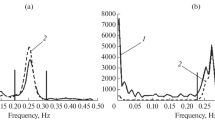Abstract
A new signal processing method for the detection of cyclic variations in atrial fibrillation frequency is presented. The objective was to investigate whether or not respiration, through the autonomic nervous system, modulates the fibrillation frequency in patients with permanent atrial fibrillation. A group of eight patients with permanent atrial fibrillation, atrioventricular block III and a permanent pacemaker were studied during rest, rhythm-controlled respiration, with each breath lasting for 8s (i.e. a breathing frequency of 0.125 Hz), and rhythm-controlled respiration after full vagal blockade by atropine. Using the new method, a spectral peak could be detected, in two of the patients, at the breathing frequency during rhythm-controlled respiration then disappeared after injection of atropine.
Similar content being viewed by others
References
Akselrod, S. (1995): ‘Components of heart rate variability: basic studies’, inMalik, M., andCamm, A. J. (Eds.): Heart rate variability, chap. 12 (Futura Publishing, 1995), pp. 147–163
Akselrod, S., Gordon, D., Ubel, F. A., Shannon, D. C., andBargar, A. C. (1981): ‘Power spectral analysis of heart rate fluctuation: a quantitative probe of beat-to-beat cardiovascular control’,Science,213, pp. 220–222
Bollmann, A., Kanuru, N., McTeague, K., Walter, P., DeLurgio, D., andLangberg, J. (1998): ‘Frequency analysis of human atrial fibrillation using the surface electrocardiogram and its response to ibutilide’,Am. J. Cardiol.,81, pp. 1439–1445
Bollmann, A., Mende, M., Neugebauer, A., andPfeiffer, D. (2002): ‘Atrial fibrillatory frequency predicts atrial defibrillation threshold and early arrhythmia recurrence in patients undergoing internal cardioversion of persistent atrial fibrillation’,Pacing Clin. Electrophysiol.,25, pp. 1179–1184
Holm, M., Pehrsson, S., Ingemansson, M., Sörnmo, L., Johansson, R., Sandhall, L., Sunemark, M., Smideberg, B., Olsson, C., andOlsson, B. (1998): ‘Non-invasive assessment of atrial refractoriness during atrial fibrillation in man—introducing, validating and illustrating a new ECG method’,Cardiovasc. Res.,38, pp. 69–81
Kim, K. B., Rodefeld, M. D., Schuessler, R. B., Cox, J. L., andBoineau, J. P. (1996): ‘Relationship between local atrial fibrillation interval and refractory period in the isolated canine atrium’,Heart,94, pp. 2961–2967
Lammers, W., Allessie, M., Rensma, P., andSchalij, M. (1986): ‘The use of cycle length to determine spatial dispersion in electrophysiological properties and to characterize the underlying mechanism of fibrillation’,New Trends Arrhythmias,II
Langley, P., Bourke, J. P., andMurray, A. (2000): ‘Frequency analysis of atrial fibrillation’.Proc. Computers in Cardiology, IEEE Computer Society, pp. 65–68
Pagani, M., Lombardi, F., Guzzetti, S., Rimoldi, O., andFurlan, R. (1986): ‘Power spectral analysis of heart rate and arterial pressure variabilities as a marker of sympatho-vagal interaction in man and concious dog’,Circ. Res.,59, pp. 178–193
Parzen, E. (1963): ‘On spectral analysis with missing observations and amplitude modulation’,Sankya A,25, pp. 383–392
Rieta, J. J., Zarzoso, V., Millet Roig, J., Garcia Civera, R., andRuiz Granell, R. (2000): ‘Atrial activity extraction based on blind source separation as an alternative QRST cancellation for atrial fibrillation analysis’.Proc. Computers in Cardiology, IEEE Computer Society, pp. 69–72
Rosen, Y., andPorat, B. (1989): ‘The second-order moments of sample covariances for time series with missing observations’,IEEE Trans. Inform. Theory,35, pp. 334–341
Stridh, M., andSörnmo, L. (2001): ‘Spatiotemporal QRST cancellation techniques for analysis of atrial fibrillation’,IEEE Trans. Biomed. Eng.,48, pp. 105–111
Stridh, M., Sörnmo, L., Meurling, C. J., andOlsson, S. B. (2001): ‘Characterization of atrial fibrillation using the surface ECG: time-dependent spectral properties’,IEEE Trans. Biomed. Eng.,48, pp. 19–27
Stridh, M., Sörnmo, L., Meurling, C. J., andOlsson, S. B. (2003): ‘Sequential characterization of atrial tachyarrhythmias based on ECG time-frequency analysis’,IEEE Trans. Biomed. Eng. (in press)
Author information
Authors and Affiliations
Corresponding author
Rights and permissions
About this article
Cite this article
Stridh, M., Meurling, C., Olsson, B. et al. Detection of autonomic modulation in permanent atrial fibrillation. Med. Biol. Eng. Comput. 41, 625–629 (2003). https://doi.org/10.1007/BF02349969
Received:
Accepted:
Issue Date:
DOI: https://doi.org/10.1007/BF02349969




